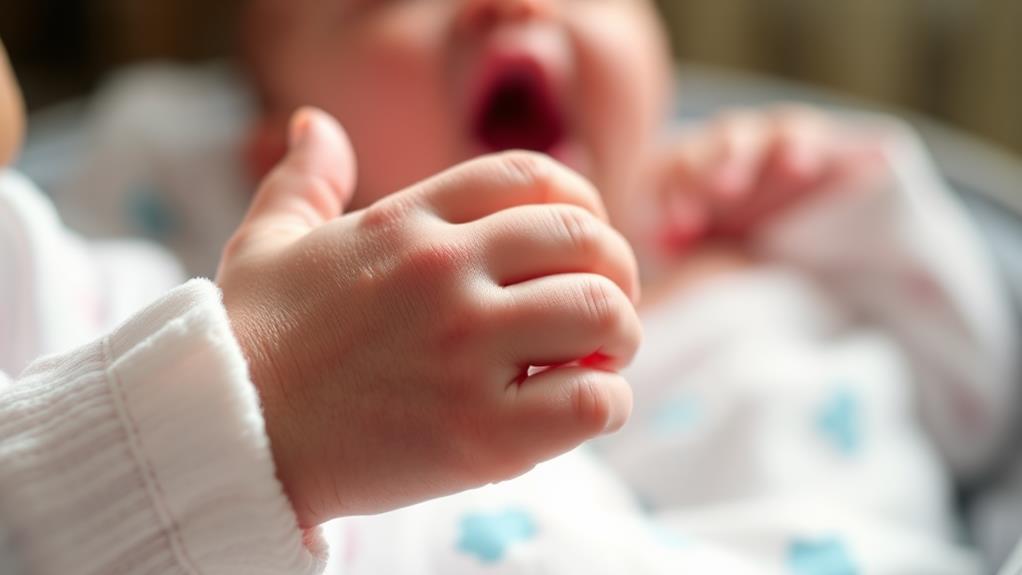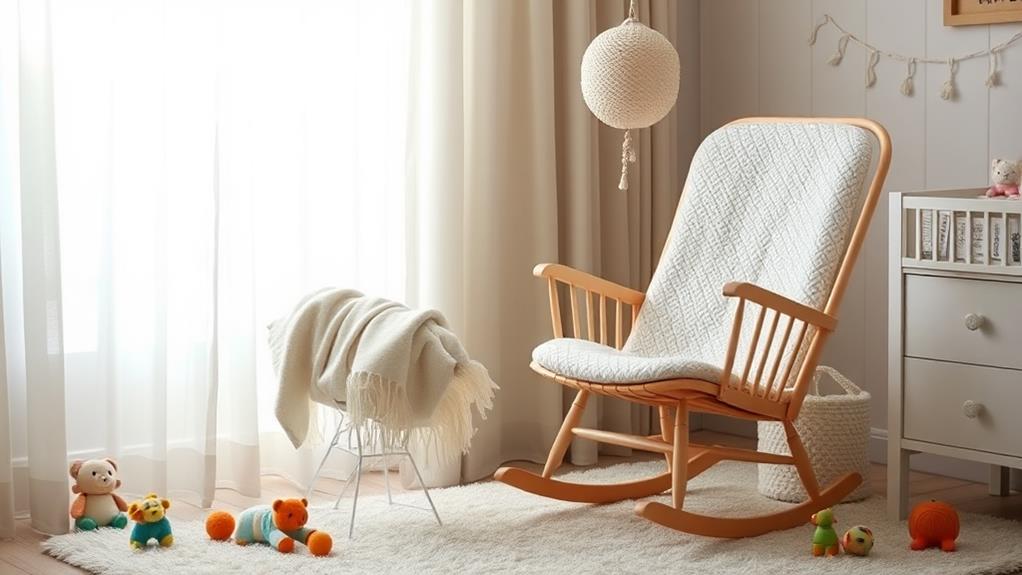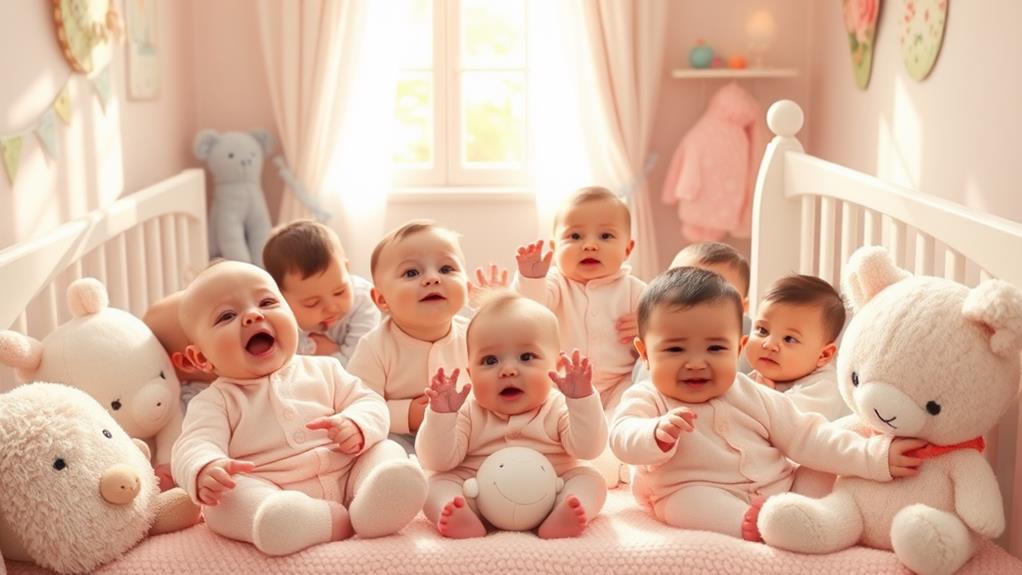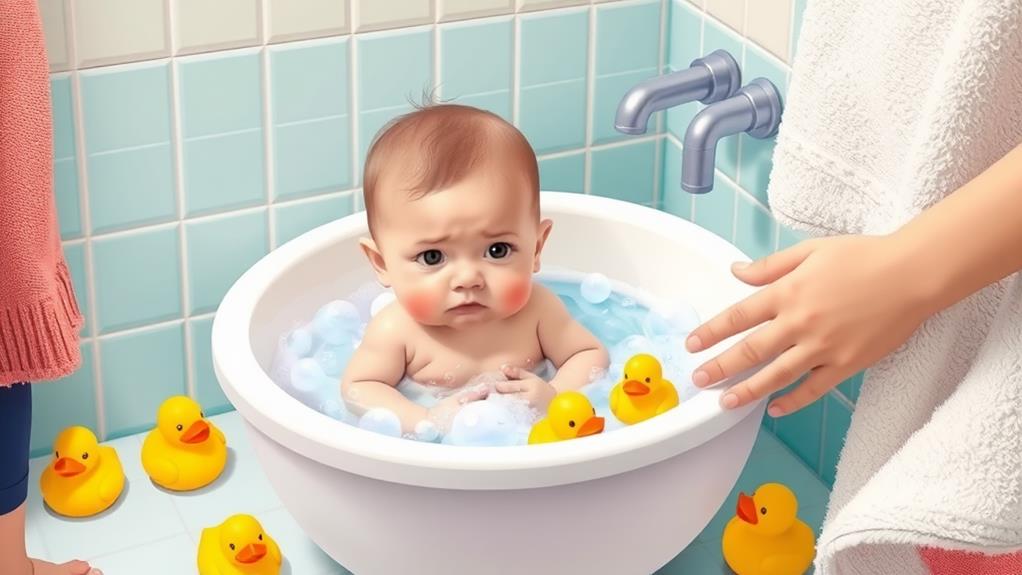You might think understanding your baby's cues is straightforward, but it often involves more nuance than you'd expect. Every coo, frown, and wiggle can signal different needs or feelings that require your attention. Knowing how to interpret these signals not only helps you respond appropriately but also strengthens your connection with your child. As you navigate this journey, you'll discover specific signs that reveal what your baby is truly trying to communicate. Curious about what those signs are and how to interpret them effectively?
Understanding Baby Cues

Understanding baby cues is essential for fostering a strong bond between you and your infant. Babies are like little detectives, giving you non-verbal clues about what they need or how they feel. These baby cues can be expressed through body language, sounds, and actions before they even learn to talk.
For example, if your baby arches their back, it might mean they're uncomfortable. On the other hand, if they're making eye contact and smiling, they're probably looking for some fun interaction!
It's important to pay attention to these signals because misinterpreting them can lead to frustration for both you and your little one. Maybe they're crying because they're hungry, or perhaps they just need a cuddle.
Context matters too! If it's been a while since their last feeding or diaper change, that can help you figure out what's going on.
Importance of Responding
Responding to your baby's cues is crucial for building a strong, trusting relationship. When you respond to baby cues promptly, it creates a sense of safety and security for your little one. This helps them feel secure, knowing that their needs are being met.
Plus, timely responses can help prevent frustration for both you and your baby, making your caregiving experience smoother.
By consistently acknowledging baby cues, you support their emotional development and teach them valuable communication skills. Think of it as a little dance; the more you tune in to their signals, the better you both get at it.
Engaging with your baby enhances their socio-emotional growth and encourages healthy attachments. It's like building a bridge between you two, one cue at a time.
Understanding and responding to cues also reduces the chances of misinterpretation, which can lead to stress for both of you.
So next time your baby fusses or coos, remember that your response matters. It's not just about meeting their needs; it's about strengthening that special bond you share.
And who doesn't want a little extra love in their life?
Common Baby Cues

Then there's smiling. When your baby flashes that adorable grin, it usually means they're feeling happy and want to engage with you. It's like their own little invitation to connect!
Eye contact is also a big deal; when your baby looks into your eyes, it shows they're interested and ready to interact.
Watch for physical cues, too! If your baby arches their back, they might be uncomfortable or full. And if they're grabbing their ears, they could be teething or just discovering their own body—how cute is that?
Don't forget about body language; relaxed movements often mean your baby feels safe and content, while a grimace can signal pain.
Physical Cues Overview
How can you tell what your baby needs just by watching their movements? Understanding baby body language is key! Physical cues are vital indicators of your little one's emotional and physical needs.
For instance, if your baby arches their back, they might be feeling uncomfortable or even full. You might notice them grabbing their ears—this can mean they're teething or just discovering those cute little ears. But if they've a fever, it could be a sign of an ear infection.
Then there's head-banging, which is often a self-soothing technique. It's pretty common before naps, and thankfully, most kids outgrow it by age three!
Kicking is another interesting cue. If your baby's kicking happily, they're probably enjoying themselves and developing those muscles. But if the kicking seems grumpy, they might need a diaper change.
And don't overlook the scrunched knees; this can indicate gassiness or constipation. A gentle tummy massage might just do the trick!
Signs of Discomfort

Many signs can indicate that your baby is feeling uncomfortable. If your baby is crying, it's often a big red flag. Pay attention to their body movements too! For instance, if you see them clenching their fists, they might be feeling stressed or hungry. A relaxed body usually means your little one is content, while body tension can signal discomfort or anxiety.
You might notice your baby scrunching their knees; this could mean they're gassy or constipated. Gentle tummy massages can really help ease that discomfort.
Also, keep an eye out for grimacing or fussing—these cues can indicate pain or distress, so it's good to act quickly if you notice them.
If you think your baby is overstimulated, they might just need some quiet time. A calm environment can work wonders!
Feeding Cues
What're the signs that your baby is ready to eat? Paying attention to your baby's cues can make feeding time smoother and more enjoyable. Early feeding cues include sucking on fingers, smacking their lips, or even turning their head toward the breast. These signs indicate they're ready to eat, often before they start crying.
You might also hear small sounds like cooing or grunting, which are gentle nudges that it's time to feed. During feeding, watch for hand movements. If your little one reaches out or grasps, it's a good sign they're comfortable and want to continue eating.
Remember, crying is a late hunger cue, so responding to those earlier signs helps prevent them from becoming upset. Nobody likes a hangry baby!
Using responsive feeding practices, like feeding on demand instead of sticking to strict schedules, supports healthy eating habits. This approach can help avoid problems like overeating.
Sleep Cues

Recognizing your baby's sleep cues is essential for ensuring they get the rest they need. You might notice your little one rubbing their eyes, yawning, or having droopy eyelids—these are all clear signs that it's time for a nap. If your baby starts fussing or losing interest in their toys, they may be overstimulated and ready to sleep.
Paying attention to these sleep cues can help you create a consistent sleep routine, which is super important for their development. Remember, newborns usually sleep for just 1 to 2 hours at a time, so being quick to respond to their cues is key. If you wait too long, you might find your baby is fussier than usual, making it harder to settle down.
And just to clarify, if your baby is hungry, they'll show different signs, like rooting or smacking their lips. So, keep an eye out!
Gastrointestinal Signs
Watching for gastrointestinal signs in your baby can greatly improve their comfort and well-being. Babies often experience hiccups, which are usually harmless and can happen after overfeeding. If your little one starts hiccuping, don't worry; it'll likely pass quickly!
You might also notice spitting up, especially if they swallow air during feeding. Keeping an eye on feeding techniques can help reduce this.
Pay attention to their body language too! If your baby is grimacing or grunting, they might be getting ready to poop. This can signal gastrointestinal discomfort, and a gentle belly rub might help them relax.
When babies scrunch their knees, it might mean they're gassy or constipated. Tummy massages can work wonders here and get those little legs moving again!
Reflexes and Reactions

As your baby grows, you'll notice their reflexes and reactions kicking in, providing important clues about their development.
These little jerks and movements, like the startle reflex—also called the Moro reflex—are totally normal. When your baby hears a loud noise or feels a sudden movement, they might flail their arms and legs. This usually fades away by three to six months, but it's a sign their nervous system is developing well.
You might also catch your baby's grasp reflex, where they hold onto your finger tightly. It's like a little security blanket for them!
Plus, there are rooting and sucking reflexes that help them latch onto your breast for feeding—talk about survival skills!
Developmental Milestones
Understanding your baby's reflexes and reactions sets the stage for tracking their developmental milestones. These milestones are like little checkmarks on your baby's growth journey, showcasing their physical and social achievements.
Around six months, you might notice your baby rolling over, sitting up with support, and engaging more with you through smiles and cooing. It's such a joy to see those adorable expressions, isn't it?
Then, as they reach about one year, your little one may start crawling, pulling themselves up to stand, and even waving goodbye! Those actions are big signs of their growing independence and social skills.
While each baby develops at their own pace, consistently tracking these developmental milestones can give you peace of mind and help spot any areas needing extra support.
Regular pediatric check-ups are essential, too, as they help ensure your baby's growth is on track. So, keep an eye out for your baby's cues and celebrate every little achievement!
After all, every smile, coo, and wiggle is a step closer to all the wonderful things they'll do. Just think, one day they'll be running around, and you'll wonder where the time went!
Community Support

Building a supportive community around your parenting journey can make a world of difference when it comes to reading baby cues. When you connect with other parents, you share experiences and gain reassurance. This shared understanding can help you feel more confident in your ability to interpret your baby's needs.
Engaging in discussions with fellow caregivers allows you to swap tips and strategies for responding to those important baby cues. Whether it's through support groups, online forums, or local meet-ups, you'll find a wealth of knowledge that can boost your skills. Plus, you might discover some expert articles or resources that provide valuable insights.
Participating in community events or workshops focused on infant development can be a fun way to learn together. Imagine chatting with other parents while picking up new tricks for understanding your little one!
Building this network not only makes parenting challenges easier but also helps you feel less alone. After all, parenting is a wild ride, and it's much more enjoyable when you're surrounded by others who get it. So, don't hesitate to reach out and create that community support you and your baby deserve!
Resources for Learning
When it comes to learning about baby cues, a variety of resources can help you become more attuned to your little one's needs. Expert articles and books offer in-depth info on understanding body language and the nuances of infant communication. These resources can really open your eyes to what your baby might be trying to tell you!
Video resources are also super handy, showing common baby cues in action. It's like having a mini class right in your living room!
Plus, community support groups and online forums let you connect with other caregivers. Sharing experiences and advice can help you learn even more about recognizing those tiny signs.
Don't forget about parenting workshops and classes, where you can practice in real-time. It's one thing to read about baby cues, but it's another to actually see them and respond.
Lastly, keeping up with reputable websites ensures you're always in the know about the latest research on infant development. With all these resources at your fingertips, you'll be a pro at reading your baby's cues in no time!
Consultation and Guidance

Consulting with professionals can make a significant difference in interpreting your baby's cues. If you notice persistent signs like frequent crying or signs of discomfort, it's wise to seek a pediatrician's advice. They can help identify if there's an underlying health issue that needs attention.
Plus, keeping an eye on your baby's patterns—like changes in eating, sleeping, or social engagement—can be crucial. These patterns may signal areas that require professional evaluation.
Community support groups can also be a treasure trove of information. Hearing from other parents about their experiences can help you understand your baby's signals better. It's like a mini support network where everyone gets it!
Don't forget about the specialists, too! Lactation consultants and child development specialists offer great guidance that can enhance your responses to feeding and developmental cues.
And let's not skip those regular pediatric check-ups! They're essential for tracking your baby's growth and addressing any unusual behaviors.
Emotional Development Insights
Understanding your baby's emotional development is key to fostering a strong bond and a sense of security. When you respond to your baby's cues—like their little grumpy faces or big smiles—you're not just playing; you're building trust.
Babies are amazing communicators! They use body language to express how they feel. A smile means they're happy, while a furrowed brow could mean they're not so thrilled.
Eye contact plays a vital role, too. When your baby looks into your eyes, it shows they're interested and engaged. This connection enhances their social skills and helps them feel secure.
Plus, creating a safe and nurturing environment gives them the freedom to explore their emotions, which is super important for healthy emotional development.




